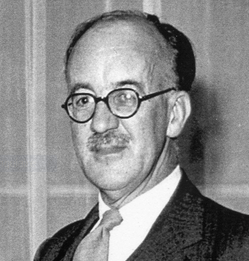John Gaddum facts for kids
Quick facts for kids
Sir John Gaddum
FRS FRSE
|
|
|---|---|

John Gaddum, c. 1960
|
|
| Born |
John Henry Gaddum
31 March 1900 Hale, Cheshire, England
|
| Died | 30 June 1965 (aged 65) Cambridge, England
|
| Nationality | British |
| Alma mater | Rugby School Trinity College, Cambridge |
| Known for | first scientist to postulate that 5-HT might have a role in mood regulation |
| Awards | Fellow of the Royal Society Member of the German Academy of Sciences Leopoldina |
| Scientific career | |
| Fields | Pharmacology |
| Institutions | Cairo University University College London University of Edinburgh Porton Down |
Sir John Henry Gaddum (born March 31, 1900 – died June 30, 1965) was an important English scientist. He was a pharmacologist, which means he studied how medicines and other chemicals affect the body.
In 1931, he worked with another scientist, Ulf von Euler, to discover a special chemical in the body called Substance P. This chemical helps send messages in the brain. Sir John Gaddum also helped start the British Pharmacological Society. This is a group for scientists who study pharmacology. He was also the first editor of the British Journal of Pharmacology, a science magazine.
Contents
Early Life and School
John Gaddum was born in a town called Hale, which is now part of Manchester, England. His father, Henry Edwin Gaddum, was a silk merchant. John went to school at Moorland House School and then Rugby School. After that, he studied at Trinity College, Cambridge.
He earned his first science degree, a BSc in Physiology, from the University of Cambridge in 1922. Physiology is the study of how living things work. In 1925, he received his MD degree from University College London. His first job was helping another scientist, J. W. Trevan, at a research lab called Wellcome Physiological Research Laboratories.
Amazing Discoveries
From 1927 to 1933, John Gaddum worked with Henry Hallett Dale at the National Institute for Medical Research. Here, he helped figure out important rules about how different medicines work in the body. He showed that special nerves, called sympathetic nerves, release a chemical called adrenaline. Adrenaline is what makes you feel excited or scared.
Working with Ulf von Euler, he also found that another chemical, acetylcholine, is released in parts of the nervous system called autonomic ganglia. These discoveries helped scientists understand more about how our bodies react to things.
Teaching and Leadership
John Gaddum became a professor of pharmacology. From 1933 to 1935, he taught at the University of Cairo in Egypt. Then, he taught at University College London from 1935 to 1938. He also taught at the University of London until 1942.
During World War II, he used his science knowledge to help his country. He advised the War Office on how to deal with dangerous chemicals. He was even given the rank of Lieutenant Colonel in the army.
From 1942 to 1958, Gaddum was a professor at the University of Edinburgh in Scotland. He was a very respected scientist. In 1943, he became a member of the Royal Society of Edinburgh. This is a famous group of scientists. In 1945, he also became a member of the even more famous Royal Society of London.
From 1958 until he passed away in 1965, he was the director of the Institute of Animal Physiology. This place is now known as the Babraham Institute. It studies how animals' bodies work.
Honors and Legacy
In 1964, John Gaddum was given a very special honor. He was made a Knight Bachelor by The Duke of Edinburgh. This meant he could be called "Sir John Gaddum."
He was the first scientist to suggest that a chemical called 5-HT might be important for how we feel. This idea helped other scientists study how our mood is controlled in the brain.
In 1962, he was chosen to be a member of the German Academy of Sciences Leopoldina. This is another important science group in Germany. In 1964, Edinburgh University gave him an honorary doctorate degree. This was to recognize his great work.
Sir John Gaddum passed away in Cambridge on June 30, 1965. There is a special plaque near the Babraham Institute to remember him and his contributions to science.
Family Life
In 1929, John Gaddum married Iris Mary Harmer. They had three daughters together: Susan, Ann, and Phyllis.

